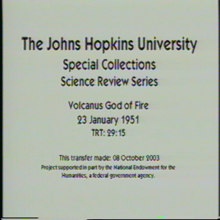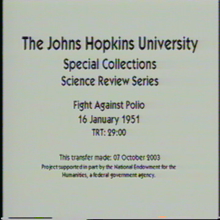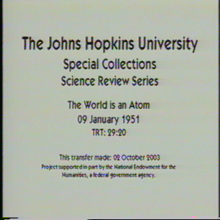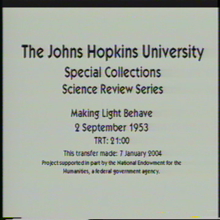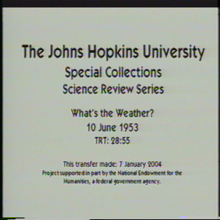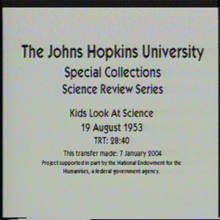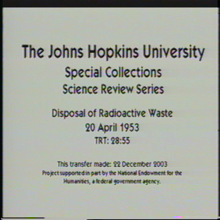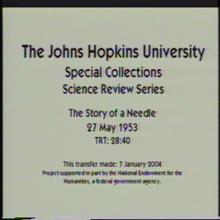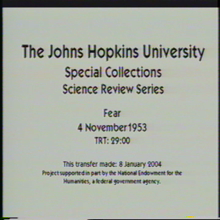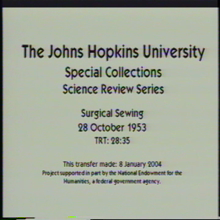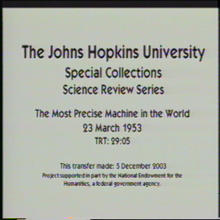Abstract:
Research in human engineering affects many operations of everyday life Experimentation with sizes and shapes of numbers knobs and traffic signs can make driving safer and machines easier to operate The first eight or nine minutes are missing from the videorecording of this program
Date Published:
1951-01-30
Abstract:
Volcanoes are found in certain areas of the earth that are also susceptible to earthquakes Pressure beneath the crust of the earth forces lava and hot rocks up through the crater of volcanoes Various types of lava and volcanic rocks are discussed
Date Published:
1951-01-23
Abstract:
The program begins with a tour of the Childrens Hospital School of Baltimore Maryland Dr Raymond Lenhard describes the symptoms of poliomyelitis or infantile paralysis and treatment of the disease In the exercise room a physical therapist demonstrates the muscle test for fingers and shoulders and how patients progress from simple to complex exercises Patients are shown in crutches and leg braces in the rocking bed and in the treatment pool doing underwater exercises Iron lung respirators are demonstrated and explained Lynn Poole interviews two patients who recovered from polio and he alludes to research being done in polio immunization
Date Published:
1951-01-16
Abstract:
The need to see cells in motion in high magnification led to the development of the television microscope
Date Published:
1951-05-15
Abstract:
This program describes the atom as the smallest structure in the universe and how they combine to form molecules Molecules combine together to create larger structures that can react and combine with each other
Date Published:
1951-01-09
Abstract:
Lynn Poole discusses the work of an industrial hygienist and notes that although there are many aspects of industrial hygiene this program focuses on atmospheric contamination and its remediation Dr Anna M Baetjer describes dusts especially silica dust and solvents especially carbon tetrachloride and the research being done to determine their effect on human workers Charles E Couchman a Baltimore city industrial hygienist demonstrates how carbon monoxide testing can be done with an instrument Hopcalyte developed at Johns Hopkins University and University of California is used to reduce carbon monoxide levels Allen D Brandt an engineer for Bethlehem Steel shows photographs of exhaust systems at local industries and the collection and removal of particulate matter
Date Published:
1951-03-27
Abstract:
Beams of light can be controlled by polarization by rotating polaroid filters to focus or block out light Cross polarizer filters can eliminate car headlight glare at night and reduce reflection on camera lenses microscopes compasses for polar navigation and the brightness of white paper Sunglasses also use polaroid lenses that aid drivers by cutting down on pavement glare
Date Published:
1953-09-02
Abstract:
Air temperature barometric pressure and humidity in the upper atmosphere can be measured by instruments inside a radio sound box that is carried into the air by balloon The measurements are carried back to earth by a radio transmitter in the box Radar is used to track hurricanes and tornadoes through a network of weather stations throughout the United States These data are used to provide early warning to residents that are in the paths of tornadoes and hurricanes
Date Published:
1953-06-10
Abstract:
The sixth grade summer school class at Johns Hopkins University presents an episode of the Johns Hopkins Science Review to illustrate what they have learned from Johns Hopkins scientific researchers during the summer Highlighted are discussions on hydrology airplane wing design weather forecasting electromagnets and nursing The students portrayed the roles of Mr Poole and the researchers of Johns Hopkins University and the jobs of producer director stage manager and camera operators on the simulated show Kids look at science
Date Published:
1953-08-19
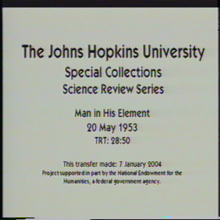
Abstract:
Before the program begins Jerome Spingarn on the Board of the National Association for Better Radio and Television presents to Lynn Poole the television award for Outstanding Educational Program for the second consecutive year As an introduction to the show Mr Poole reads from Sir Charles Blagdens 1774 Experiments and Observations in a Heated Room about the dangers of overheating Dr Lee then describes the operation of Johns Hopkins Universitys Mobile Climatic Laboratory built for the Quartermaster Corps The lab consists of an engine room with generators an anteroom with controls and a climatic chamber with treadmill and other equipment Test subjects are wired to provide data to a recorder as they exercise on a treadmill under different temperature and humidity levels Oxygen analysis and perspiration evaporation measurements are also explained Dr Lee shows a film and photos of graduate students doing preliminary testing of the labs equipment before its use in the Yuma Arizona desert
Date Published:
1953-05-20
Abstract:
Mr MillerJones introduces this program on the dangers of radioactive fallout the third in a series of exchanges between Baltimore Marylands station WAAM and Great Britains BBC Dr Kruse explains that current incineration of radioactive waste could be detrimental to peoples health if safe gas and ash levels are exceeded Dr Geyer and Mr Talboys discuss the effectiveness of laundering of radiumtainted clothing To improve removal of radioactive materials from clothing combinations of several variables must be considered isotopes fabrics fiber weave treatment detergents concentrations water temperatures agitation degree and time Dr Renn then examines the problems of releasing radioactive waste into sewage treatment plants Some waste such as radiophosphorous is easily absorbed by bacteria in the system others could be captured by experimental trickling filters or the aerated sludge process but the sludge must then be disposed
Date Published:
1953-04-20
Abstract:
Dr Proctor discusses examples of and reasons for hypodermic injection rather than oral administration of drugs examines injection methods and shows various styles and construction of syringes He also gives a historical account of development of the hollow needle and intravenous injection by such scientists as Serturner Pravaz Wood Osler LaFarge and Wren Dr Walter Dandy professor of surgery at Johns Hopkins shows the endemic method of applying a drug to the skin by blistering the skin He also offers examples of and reasons for the need to administer drugs hypodermically rather than orally Using an orange a nurse demonstrates the method for teaching laymen how to administer an insulin injection
Date Published:
1953-05-27
Abstract:
Dr Shaw defines fear as a strong desire to escape from perceived danger to which the autonomic nervous system responds As an example of one way to measure the extent of the fear response Dr Shaw shows a film of Dr Charles Eriksen throwing a live snake at a woman to record her galvanic skin response and heart rate Dr Eriksen later demonstrates that familiarity and experience can be used to overcome a fear Dr Shaw describes the difference between fear and caution and explains that fears are more likely to become pathological than other emotions Phobias are irrational fears associated with specific objects usually associated with an intense or unusual experience in childhood Examples of typical phobias include acrophobia claustrophobia xylophobia dromophobia agoraphobia monophobia zoophobia ailurophobia topophobia and myctophobia In an experiment to learn if a person could be conditioned to fear J B Watson and Rosalie Rayner taught a child to fear a harmless object
Date Published:
1953-11-04
Abstract:
Lynn Poole welcomes station WFIETV in Dayton Ohio where Paul Kane former Science Review Director is the new stations manager Then using a diagram Dr Firor explains that sutures are necessary when a wound is deep and tissues cannot be brought together with a BandAid A film illustrates the healing process in a microscopic view of white blood cells carrying out phagocytosis destruction of bacteria Dr Firor then summarizes the history of wound closure techniques from the Edwin Smith papyrus detailing the Egyptians procedures in 1600 BC to the introduction of gold thread by Fabricius in 1550 to South American Indians use of soldier ants bites to clamp wounds closed A film dramatizes late nineteenth century improvements on Listers methods of surgical cleanliness and the use of violin strings and cat gut as sutures Dr Firor shows current sutures made by commercial firms of nylon linen silk and stainless steel wire and the needles used with them
Date Published:
1953-10-28
Abstract:
Lynn Poole describes a diffraction grating as having ridged scales like a butterflys wings that create iridescence The 75000 precise ridges must be so accurately spaced that it requires a special machine to make a diffraction grating Dr Henry H Rowland developed the first one in 1860 but Dr John Strong refined this machine the ruling engine in 1950 Using a model of the machine Dr Strong explains the operation of a ruling engine focusing on the perfect twin screws that are its vital parts The maker of these screws David Broadhead of Wellsville NY demonstrates how one cuts one of these screws on a machine lathe In a film Wilbur Perry one of the most accomplished mechanical and optical technicians in making diffraction gratings constructs parts of the ruling engine including the diamond used to cut the 75000 grooves on the aluminumcoated glass Diffraction grating is the basis of spectroscopy separating light into various colors for analysis
Date Published:
1953-03-23


